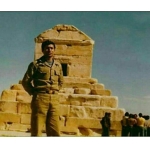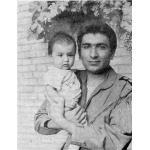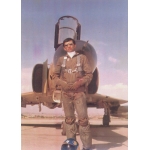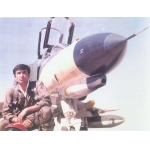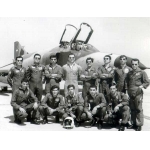Doran, Abbas
Milad Shavikloo
1292 بازدید
Abbas Doran (1950-1982) was an acclaimed fighter pilot serving in the Islamic Republic of Iran Air Force. He played a significant role in defending his homeland during the early years of the Iran-Iraq War by participating in and commanding numerous aerial operations.
Abbas Doran was born on October 12, 1950, in Shiraz. After completing primary education, he attended Soltani High School in Shiraz. In 1969, after receiving a diploma, he joined the Air Force to take the introductory flight course. In 1970, he was admitted to the Flight Academy. After initial flight training in Iran, he went to the United States in 1972 to complete his pilot training. First, he underwent advanced English language training at Lackland Air Base in Texas. Then he attended the Undergraduate Pilot Training Program at Columbus Air Force Base in Mississippi, where he learned to fly the Bonanza T-41 and T-47. In 1973, after being awarded his pilot’s flying badge, he returned to Iran and started serving as an F-4 Phantom pilot at the 1st Fighter Base in Tehran, and later at the 3rd Fighter Base in Hamedan. On July 13, 1979, Abbas Doran married Narges Khatoon Dalir Rooyfard. The couple had a son, Amir Reza, who was only eight months old when his father was martyred.
With the onset of the Iran-Iraq War, Doran was transferred to the 6th Fighter Base in Bushehr.[1] At that time, only he and another Air Force pilot, Ali Reza Yasini, could launch radar-guided air-to-surface missiles in the Persian Gulf region. The Iraqi Navy even placed a bounty on Iranian warplanes. However, during Operation Morvarid, carried out on November 27-28, 1980, the remaining Iraqi Navy vessels were destroyed as a result of the precise air strikes led by Abbas Doran and his comrades.[2]
In the early hours of the battle, Doran destroyed two Iraqi naval vessels near the al-Amaya and al-Bakr oil terminals. He and his fellow pilots continued flying throughout the operation, with Doran immediately re-boarding a ready aircraft after each landing to continue the air battle.[3]
A few months after the war broke out, Saddam Hussein, in an interview with a BBC reporter, said: “With the help of our allies, we have recently established such a formidable air defense system around our cities and economic assets, including power plants, that if any Iranian pilot manages to reach within 50 miles of these power plants’ defense rings, I will give him one year of my salary.” A few hours after this interview, Abbas Doran, along with pilot Yasini, destroyed the Basra power plant, plunging southern Iraq into darkness. The reporter who had interviewed Saddam immediately broadcast the news of the destruction of the Basra power plant.[4]
In the spring of 1981, to honor the bravery of this pilot, Shiraz’s political and military authorities named one of the city’s boulevards, located across from the Shiraz Air Base,[5] after Abbas Doran. Before Operation Fath al-Mobin (March 22, 1982), the Iraqis had moved their troops on a large scale and transferred their equipment to the southern frontlines. After gathering the necessary intelligence and preparing flight maps, Iranian authorities decided to conduct an airstrike to destroy the enemy’s rear positions and equipment. On March 20, 1982, Abbas Doran, as the squadron leader, along with 15 other Air Force pilots, was chosen to carry out this mission. This operation paved the way for the liberation of Khorramshahr through Operation Beit al-Muqaddas (April 30, 1982).[6]
Before the war with Iran, during the Non-Aligned Movement Summit in Havana, Saddam Hussein had secured the hosting rights for the next meeting, scheduled for the summer of 1982. The Iranian Ministry of Foreign Affairs made extensive efforts to cancel the summit in Baghdad. However, when diplomatic efforts failed, Iran’s military and political leaders decided to create insecurity in Baghdad. An army plan was devised to attack the Al-Doura refinery in southeastern Baghdad to cancel the summit. The mission was assigned to the Air Force, and six distinguished Air Force pilots, led by Abbas Doran, were selected to carry out the mission with three Phantom jets. On July 21, 1982, Doran, along with co-pilot Mansour Kazemian and four other pilots, flew out to attack the Al-Doura refinery in Baghdad. To evade Iraqi radars, the two other aircraft in Doran’s squadron flew at low altitudes, but Iraqi radar systems detected the Iranian aircraft and fired at them. After striking the refinery and breaking the sound barrier over Baghdad, Abbas Doran’s aircraft was hit by Iraqi missiles. Mansour Kazemian requested an emergency ejection, but Doran activated the rear ejection seat to allow Kazemian to parachute safely. He then directed his aircraft into the Al-Rashid Hotel, where the summit was to be held, and crashed into the building, causing significant damage. As a result, he was martyred, and his actions caused the summit to be held in New Delhi instead of Baghdad due to security concerns.[7]
Twenty years later, on July 20, 2002, the remains of Abbas Doran’s body were returned to Iran and buried in Martyrs’ Cemetery in Shiraz.[8] During the first two years of the war, Abbas Doran completed over 120 combat missions beyond Iran’s borders, a record that, according to aviation experts, had not been reached even during the seven-year Vietnam War.[9] He is the only martyr to have had a street named after him during his lifetime.[10] In 1997, a movie titled “The Pilot (Crossing the Red Line)” was directed by Jamal Shoorjeh, produced by the cultural institute Zeytoon, and written by Seyyed Ali Reza Sajjadpour.[11]
[1] Babak, Muhammad, Biography of Major General Pilot Abbas Doran (Faateh Asman Baghdad), Tehran: Atashbar, 2016. pp. 18-22; Mushtaq, Zahra, Douran as narrated by the martyr's wife, Tehran: Revayat Fath, 2004, p. 9.
[2] Kia, Bijan, Pelak haye Asemani (Heavenly Plaques), Shiraz: Zarineh, 2010, p. 24.
[3] Zolfaghari, Ali, Introduction to the Biography of Martyr Abbas Doran, Tehran: Moka'ab, 2013, p. 5.
[4] Kia, Bijan, Pelak haye Asemani (Heavenly Plaques), pp.34-40.
[5] Shahed Yaran, No. 96 and 97, October and November 2013, p. 8
[6] Zolfaqari, Ali, Introduction to the Biography of Martyr Abbas Doran, p. 7.
[7] Babak, Mohammad, Biography of Major General Abbas Doran (Faateh Asman of Baghdad), pp. 9-40; Lotfollahzadegan, Alireza, Calendar of the Iran-Iraq War. Book 20: Obbor Az Marz (Crossing the Border), Tehran: Center for War Studies and Research of the Islamic Revolutionary Guard Corps, 2002, pp. 338 and 339; Karimi, Nabillah, Calendar of the History of the Sacred Defense, Vol. 23: Ramadan in Ramadan, Tehran: Center for Islamic Revolution Documents, 2013, p. 951.
[8] Parhizgar, Ali Akbar, Yadgar Ogab (The Eagle's Legacy): A Look at the Life of Martyr Abbas Doran, Tehran: Shahid, 2011, p. 8.
[9] Kia, Bijan, Pelak haye Asmani (Heavenly License Plates), p. 11
[10] Shahed Yaran, p. 8.
[11] Farasti, Masoud, Culture of Iranian War and Defense Films, Tehran: Saqi, 2013. p. 123.





